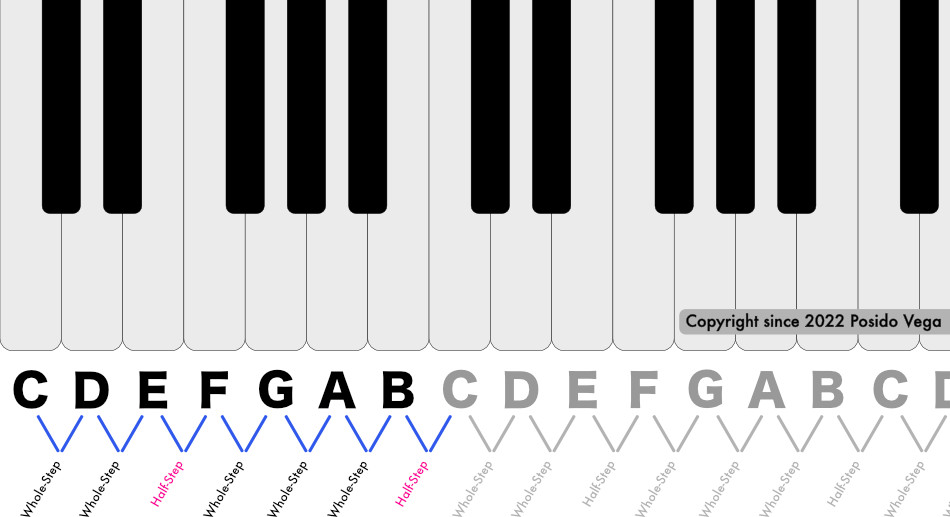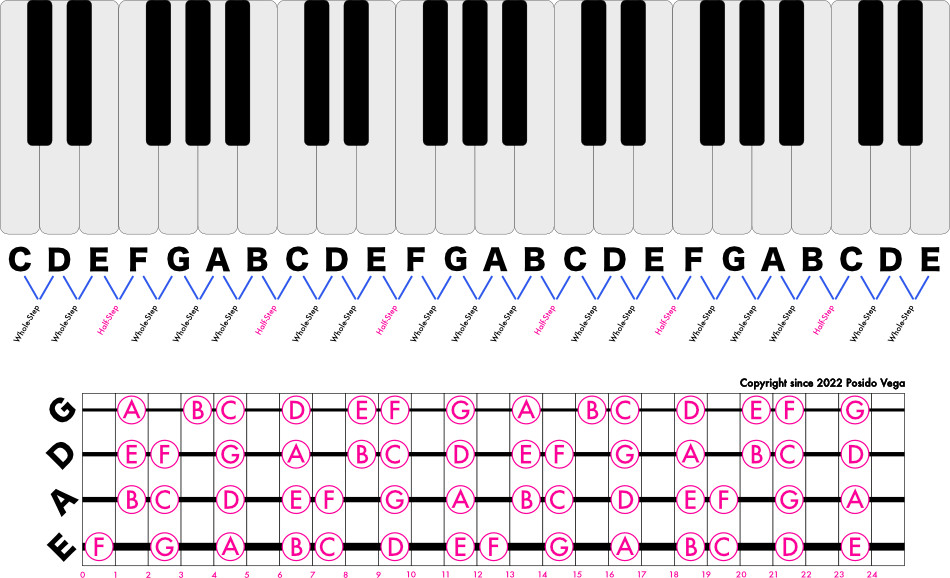For bass players of all levels, knowing your way around the fretboard is absolutely essential. It’s surprising how many bassists, even those with years of experience, still struggle to instantly recall the location of every note on their 4 string bass guitar. If you’re among them, know that you’re not alone, and more importantly, it’s entirely fixable.
Learning the notes on your 4 string bass guitar doesn’t have to be a daunting, lengthy process. The fretboard is built on a logical system, and once you grasp this underlying logic, navigating the neck and understanding bass guitar notes becomes intuitive.
In this guide, we’ll explore:
- A step-by-step method to learn all the notes on your 4 string bass guitar fretboard efficiently.
- The interval-based logic that makes learning bass notes easier than you think.
- Practical techniques to apply your knowledge and solidify your fretboard mastery.
Let’s dive in and unlock the secrets of your 4 String Bass Guitar Notes.
A 4-Step System to Learn Your 4 String Bass Guitar Notes
This method breaks down fretboard learning into manageable steps, focusing on understanding the logic rather than rote memorization.
Here’s a summary of the 4-step process:
We’ll elaborate on each step, providing diagrams and clear explanations to guide you.
Consider bookmarking this guide for easy access, especially if you’re a beginner bass player or find fretboard memorization challenging.
Step 1: Understanding the Interval Logic of Musical Notes
Western music, the foundation of most popular genres, operates with just 12 distinct notes. Learning these notes is significantly simplified by understanding their alphabetical and interval-based structure.
Key Concept: Musical notes progress alphabetically from A to G. If you know your alphabet, specifically A through G, you already have a significant head start.
The sequence of natural notes is: A, B, C, D, E, F, G. This sequence repeats across the musical spectrum: A, B, C, D, E, F, G, A, B, C, and so on. These are known as natural notes, corresponding to the white keys on a piano.
The remaining 5 notes are sharps and flats, positioned between these natural notes. They are: A♯/B♭, C♯/D♭, D♯/E♭, F♯/G♭, and G♯/A♭. These correspond to the black keys on a piano.
Notice that sharps and flats have dual names (enharmonic spelling). While pitch remains the same, the spelling depends on musical context. For now, focus on recognizing these notes; contextual spelling will become clearer as you advance.
Whole Steps and Half Steps: The Building Blocks
On a piano, black keys are inserted between most white keys, except in two crucial places.
Important Tip: There’s no black key between E and F, and no black key between B and C. This half-step relationship is crucial and applies directly to the bass guitar fretboard!
 Piano keys – Whole-Step and Half-Step Diagram
Piano keys – Whole-Step and Half-Step Diagram
Alt: Diagram illustrating whole steps and half steps on piano keys, fundamental to understanding musical intervals on bass guitar.
The distance between E and F is always a half step (one fret on the bass). Similarly, the distance between B and C is always a half step (one fret).
All other natural notes are a whole step apart (two frets).
Let’s immediately apply this interval logic to your 4 string bass guitar fretboard. This approach avoids the tediousness of purely chromatic memorization.
Step 2: Applying Interval Logic to the 4 String Bass Guitar Fretboard
Let’s recap the essential principles we’ve established:
- Musical notes are alphabetical.
- E-F and B-C are half steps.
- All other natural notes are whole steps (2 frets) apart.
Here’s the crucial link to your bass fretboard:
- Each fret on your bass represents a half step.
- Two frets equal a whole step.
On a standard 4 string bass guitar, the open string notes are E, A, D, and G, from thickest to thinnest.
 Bass Guitar Fretboard Notes and Piano Notes Diagram
Bass Guitar Fretboard Notes and Piano Notes Diagram
Alt: Bass guitar fretboard diagram showing the correlation between bass notes and piano keys for easy note learning.
Let’s start with the lowest string, the E string, to learn your 4 string bass guitar notes systematically.
Remember the half-step rule: E-F and B-C are the only natural notes without a note in between.
Finding Notes on Your E String (The Easy Way)
Starting with the open E string:
- The 1st fret on the E string is F (a half step up from E).
Using the whole and half step logic, we can find all natural notes on the E string:
- 2 frets up from F (3rd fret) is G (whole step).
- 2 frets up from G (5th fret) is A (whole step).
- 2 frets up from A (7th fret) is B (whole step).
- 1 fret up from B (8th fret) is C (half step).
- 2 frets up from C (10th fret) is D (whole step).
- 2 frets up from D (12th fret) is E (whole step – octave).
- And the pattern repeats.
Let’s apply this to the A string.
Finding Notes on Your A String (The Easy Way)
Starting with the open A string:
- 2 frets up from A (2nd fret) is B (whole step).
- 1 fret up from B (3rd fret) is C (half step).
- 2 frets up from C (5th fret) is D (whole step).
- 2 frets up from D (7th fret) is E (whole step).
- 1 fret up from E (8th fret) is F (half step).
- 2 frets up from F (10th fret) is G (whole step).
- 2 frets up from G (12th fret) is A (whole step – octave).
- And the pattern repeats.
Let’s continue to the D string.
Finding Notes on Your D String (The Easy Way)
Starting with the open D string:
- 2 frets up from D (2nd fret) is E (whole step).
- 1 fret up from E (3rd fret) is F (half step).
- 2 frets up from F (5th fret) is G (whole step).
- 2 frets up from G (7th fret) is A (whole step).
- 2 frets up from A (9th fret) is B (whole step).
- 1 fret up from B (10th fret) is C (half step).
- 2 frets up from C (12th fret) is D (whole step – octave).
- And the pattern repeats.
Finally, let’s find the notes on the G string.
Finding Notes on Your G String (The Easy Way)
Starting with the open G string:
- 2 frets up from G (2nd fret) is A (whole step).
- 2 frets up from A (4th fret) is B (whole step).
- 1 fret up from B (5th fret) is C (half step).
- 2 frets up from C (7th fret) is D (whole step).
- 2 frets up from D (9th fret) is E (whole step).
- 1 fret up from E (10th fret) is F (half step).
- 2 frets up from F (12th fret) is G (whole step – octave).
- And the pattern repeats.
Now that we understand how natural notes are laid out, let’s accelerate our learning using octaves.
Step 3: Utilizing Octaves as Fretboard Landmarks
Octaves are crucial for quickly navigating the fretboard. Think of them as signposts that help you orient yourself. While other intervals can serve a similar purpose, octaves, being the same note at a higher pitch, are particularly intuitive for beginners.
An octave represents the same note at double the frequency. On the bass fretboard, octaves appear in predictable patterns.
Learning these octave shapes will significantly speed up your fretboard knowledge.
Bass Guitar Fretboard Octaves Diagram
Alt: Visual guide to octave shapes on the bass guitar fretboard to quickly locate and memorize notes.
Here are some easy-to-remember octave shapes on your 4 string bass:
- Move two frets higher and two strings up to find an octave higher.
- Move two frets lower and two strings down to find an octave lower.
- Move three frets lower and three strings up to find an octave higher.
- Move three frets higher and three strings down to find an octave lower.
- Move five frets lower and one string up to find an octave higher.
- Move five frets higher and one string down to find an octave lower.
- Move seven frets higher and one string up to find an octave higher.
- Move seven frets lower and one string down to find an octave lower.
Step 4: Practical Application Across Musical Contexts
Steps 1-3 provide the knowledge base. Step 4 is where you solidify your understanding and learn your 4 string bass guitar notes fast through application.
Crucial Tip: There’s no substitute for playing your bass! Consistent practice and actively applying your knowledge are key to fretboard mastery.
The more you practice applying these concepts in real musical scenarios, the faster the notes will become second nature.
Incorporate exercises like:
- Playing scales and arpeggios: Focus on naming each note as you play.
- Learning bass lines: Identify the notes in familiar bass lines and analyze their fretboard positions.
- Improvising simple bass lines: Consciously think about the notes you are playing and their relationships to each other.
By actively engaging with your bass and applying your fretboard knowledge, you’ll see rapid progress.
(Bonus) Step 5: Verbalize Note Names During Practice
Enhance your learning by verbally naming each note as you practice.
Practice slowly and deliberately, prioritizing accuracy over speed.
The goal is to create a strong mental connection between the note name, its fretboard location, and its sound.
Try this exercise: Say the note name aloud, locate the fret, and then play the note. When learning to read music notation, verbally spelling out notes reinforces their fretboard positions.
Incorporate this technique during practice sessions, jam sessions, and even live performances. This active recall method strengthens your fretboard knowledge in real-time playing situations.
Your Turn to Master the Fretboard
Understanding the logic of intervals and octaves is powerful knowledge, but it truly comes alive when put into practice.
Learning your 4 string bass guitar notes is fundamental for improvisation, music reading, playing from chord charts, and confident performance.
Start applying these steps consistently, and you’ll witness significant progress in your fretboard mastery within weeks.
For further exploration and advanced techniques, consider delving into resources like My Sandbox.
Frequently Asked Questions about 4 String Bass Guitar Notes
What are the Notes on a 4 String Bass Guitar? (Standard Tuning)
In standard tuning, the 4 strings of a bass guitar are tuned to: E, A, D, and G (from thickest to thinnest).
5-string basses add a lower B string (B, E, A, D, G), and 6-string basses further add a high C string (B, E, A, D, G, C).
Standard bass tuning utilizes intervals of fourths between strings. Understanding fourth intervals, similar to octaves, can be a valuable pattern for navigating notes across strings.
What’s the Most Effective Way to Memorize Bass Guitar Notes?
Instead of focusing on rote memorization, prioritize understanding the underlying logic of note relationships and fretboard layout. Once you grasp this logic, note locations will become intuitive and make sense.
Develop good practice habits: pay attention to patterns, visualize shapes, and consistently name notes aloud during practice. Trust the process of understanding and application.
Natural memorization occurs as you build meaningful connections and relationships with the information. Recognizing patterns and shapes on the fretboard is a key way to establish these connections.
How Do I Quickly Find Notes on My 4 String Bass Guitar?
To quickly find notes, internalize the fretboard logic. Remember that a 4 string bass in standard tuning (E, A, D, G) mirrors the piano’s layout in terms of whole and half steps. Natural notes are whole steps apart, except for E-F and B-C, which are half steps. By understanding these intervals and the alphabetical sequence of notes, you can efficiently locate any note on your 4 string bass guitar fretboard.
 YouTube video
YouTube video
Alt: YouTube video tutorial: Learn your fretboard bass guitar notes fast in 4 easy steps.


